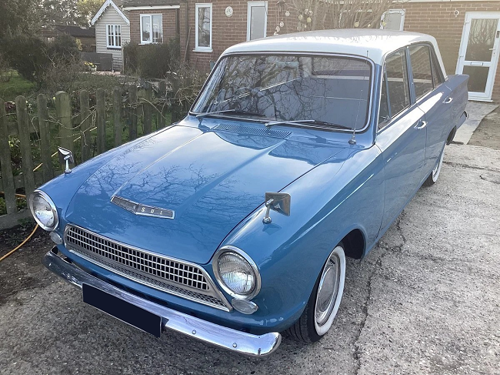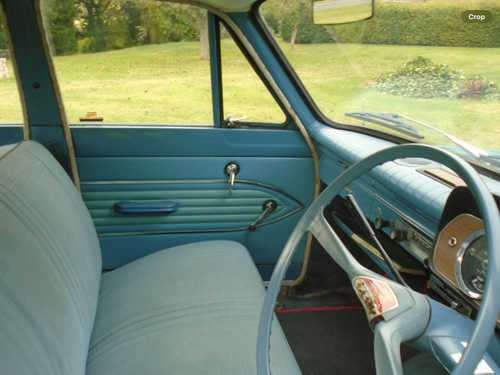1964 Ford Consul Cortina De Luxe - “small-car savings…Big-car everything else”
28 April 2025
Dean Webster’s Consul Cortina De Luxe - https://www.carandclassic.com/l/C1853032 - is a vivid reminder of how it was the prefect car for its market on launch in 1962. This was a Ford for a brave new world of Terylene suits with horizontally striped ties, That Was The Week That Was on BBC Television and using your Luncheon Vouchers at The Golden Eggs. So, in celebration, here are 50 facts about the Consul Cortina Standard, De Luxe and Super.

1. Ford started work on ‘Project Archbishop’ began in 1959.
2. The Archbishop’s narrative dates from when Ford GB’s Chair, Sir Patrick Hennessey, was visiting Head Office in the USA, when he saw Project Cardinal; a V4 front-wheel-drive saloon that Ford Germany would build as the Taunus 12M.
3. Hennessey persuaded Ford’s directors that Dagenham could build a similar-sized, rear-wheel-drive, saloon in the UK.
4. As part of his quest for the Archbishop to beat the Cardinal to market, Hennessey devised The Red Book marketing plan.
5. The criteria for the new model were it had to weigh less than 1,700lbs and bridge the gap between the Anglia 105E, which debuted in 1959, and the Consul Classic, due for launch in 1961.
6. Ford GB appointed the Chief Product Planner Terence (later ‘Sir Terence’) and Fred Hart, the Executive Engineer of Light Cars to the Archbishop programme.
7. The Chief Designer of the Archbishop was Roy Brown, who was previously responsible for the Edsel. In 1965 he told the press: “I cried in my beer for two days and then I said, ‘The hell with it. Enthusiasm got me where I was, and it’ll get me back’”.
8. Archbishop’s 1.2-litre engine was an enlarged version of the 105E’s 997cc ‘Kent’ unit.
9. The development costs were £12 million.
10. In 1961 the planned independent rear suspension was ruled out on financial grounds.
11. That year Archbishop gained ‘Ban the Bomb’ tripod taillights. Ford’s Head Office decreed horizontal rear lights were now officially "out".
12. Plans to use an Anglia 105E/Consul Classic sloping rear screen were abandoned as it made the Archbishop look "too small”.
13. While dimensionally similar to the Consul Classic, the Archbishop was 300lbs lighter.
14. Ford originally wanted to sell Archbishop as the ‘Consul 225’.
15. Sir Patrick allegedly favoured the name "Caprino" until shortly before the launch when someone discovered that this was Italian slang for goat dung.
16. In 2012 this writer noted in The Telegraph: “It was a scenario that had all of the hallmarks of a 1962 vintage British comedy, preferably starring Raymond Huntley as the chief of Ford and Jim Dale as his bumbling assistant”.
17. Ford eventually decided to name the new model after Cortina d’Ampezzo, the host resort of the 1956 Winter Olympics.
18. The Cortina name was believed to assist sales in Europe.
19. The Consul Cortina debuted on the 20th of September 1962.
20. Dagenham aimed to have a new Consul Cortina in every dealership by the time of its launch.
21. Sir Patrick proclaimed: “This is the missing model, for which thousands of growing families have asked”.
22. Sales began on the 28th of September 1962. All early cars were two-door De Luxe models in blue; two doors meant fewer body panels.
23. Your friendly local Ford dealer could highlight the Cortina’s 20 cu ft. boot and all-synchromesh four-speed gearbox.
24. Ford promised “small-car savings…Big-car everything else”.
25. Tom Karen later noted: “Having taken a Mini apart and found it to be over engineered (and under priced) the clever Product Planning people argued that making a big car doesn’t cost that much more than a little one”.

26. To publicise the Cortina, Ford commissioned this splendid PR film, complete with obligatory 1962-vintage ‘cocktail jazz’ accompaniment - https://www.youtube.com/watch?v=ckdSll5iUcE
27. The initial range consisted of two-door saloons with Standard at £639 3d or De Luxe at nearly £667.
28. De Luxe buyers still had to pay another £17 3s 9d for a heater and £1 15s for windscreen washers.
29. Should you wish to really impress your neighbours, a cigar lighter was £1 12s 6d, a reversing light £1 17s 6d and wheel trims £4 18s.
30. Four-door versions became available in October, at £657 for the Standard and £687 for the De Luxe.
31. By contrast, the Morris 1100 4-Door De Luxe was £695 7s 9d.
32. The Cortina had a top speed of 75mph with 0–60mph in 22.5 seconds.
33. Ford offered a steering column gear lever and a front bench seat for £13 15s, which was available on the two and four-door versions.
34. Market research discovered that 60% of overseas customers preferred a column change as opposed to 5% of home market buyers.
35. By the 21st of September 1962, Dagenham was building 650 Cortina per day and had £20 million of overseas orders.
36. Autocar thought the Cortina would strongly appeal to “the family man”.
37. The Telegraph found the Cortina “as quiet and smooth as any 1½ litre car, and better than most”.
38. Motor Sport rudely described the Cortina as “an acceptable vehicle for the easily-satisfied masses”.
39. The Guardian wondered if the Cortina would be a British answer “to the ubiquitous Volkswagen”.
40. January 1963 marked the launch of the Consul Cortina Super, powered by a 1.5-litre engine.
41. The Super specification included a cigarette lighter, a heater, windscreen washers and extra chrome trim.
42. The 4-door Super cost £688 2s 1d in both floor and steering column change forms.
43. Autocar regarded the Cortina Super as “extraordinarily safe and predictable”.
44. One advertisement promised a “0-60 take-off in 19.5 secs”.
45. The Super was famously publicised in Carry On Cabby, which entered production in Spring 1963. The producer Peter Rogers apparently first approached the British Motor Corporation, who wanted payment for using the Morris 1100.
46. Ford GB, with their appreciation of screen product placement, was far more amenable. During the 1960s their spending on advertising was often the highest of any UK car manufacturer.
47. The London dealership F. H. Peacock & Co of 219 Balham High Road had a contract with Pinewood Studios. They arranged the Glamcab fleet - a mixture of Dagenham PR cars and various dealer demonstrators.
48. The Cortina Super most prominently features in Cabby, with De Luxes and Standard in the background. The reason for some unlikely two-door taxis on screen was a lack of four-door Super demonstrators.
49. Ford accurately predicted the Consul Cortina was a “Potential star of the sixties”.
50. Sir Terence Beckett reflected:
The Cortina came in under cost and, most significantly, we did it in record time. I believe we took just 21 months from full-size clay style to Job 1, which was then an all-time record for the industry. We decided we needed a bigger bodyshell and we also needed more wheel movement. We decided that we would provide a proper boot – in a way we overdid that, but it was perfect for a rep who wanted to take samples, and it was perfect for the family motorist.
With thanks to Dean Webster for his time.
With thanks to Dean Webster for the permission to use the images in this blog.
